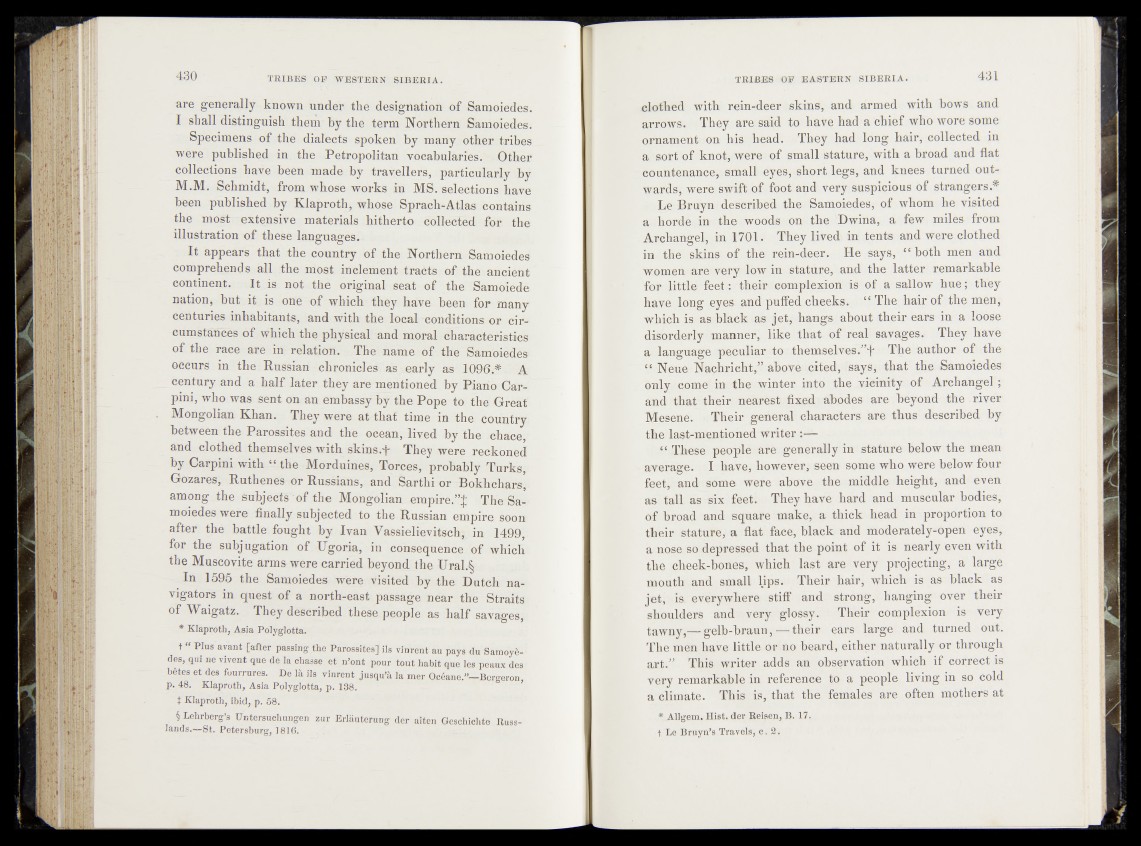
are generally known under the designation of Samoiedes.
I shall distinguish them’ by the term Northern Samoiedes.
Specimens of the dialects spoken by many other tribes
were published in. the Petropolitan vocabularies.' Other
collections have been made by travellers, particularly by
M.M. Schmidt, from whose works in MS. selections have
been published by Klaproth, whose Sprach-Atlas contains
the most extensive materials hitherto collected for the
illustration of these languages.
It appears that the country of the Northern Samoiedes
comprehends all the most inclement tracts of the ancient
continent. It is not the original seat of the Samoiede
nation, but it is one of which they have been for many
centuries inhabitants, and with the local -conditions or. circumstances
of which the physical and moral characteristics
of the race are in relation. The name of the Sainorèdes-
occurs in the Russian chronicles as early as 109&*~ A
century and a half later they are mentioned by Piarib Car^
pini, who was sent on an embassy bÿ the Pope to the Great
Mongolian Khan. They were at that time in théï.coüntry
between the Parossites and the ocean, lived by the chaee/
and clothed themselves with skins.-f They were reckoned
by Carpini with “ the Morduines, Torces, probably Turks,
Gozares, ltuthenes or Russians, and Sarthi or Bokhchars,
among the subjects of the Mongolian empire.”^; T h e ^ >
moiedeswere finally subjected to the Russian empirç. soon
after the battle fought by Ivan Vassielievitsch; in 1499;.
for the subjugation of Ugoria, in consequence . of which
the Muscovite arms were carried beyond the Ural.^
In 1595 the Samoiedes were visited by the Dutch navigators
in quest of a north-east passage near the Straits
of Waigatz. They described these people as half savages,
* Klaproth, Asia Polyglotte.
t “ Pins avant [after passing tbe Parossites] ils vinrent an pays dn Samdyè-
des, tjni ne vivent que de la chasse et n’ont pour tout habit que les peaux des
bêtes et des fourrures. De là ils vinrent jusqu’à la mer Qscéane.”—Bergeron,
y. 48. Klaproth, Asia Polyglotta, p. Ï38.
t Klaproth, ibid, p. 58.
§ Lehrberg’s Untersuchungen zur Erläuterung der alten Geschichte Russlands.—
St. Petersburg, 1816.
clothed with rein-deer skins, and armed with bows and
arrows. They are said to have had a chief who wore some
ornament on his head. They had Icing hair, collected in
a sort of knot, were of small stature, with a broad and flat
countenance*,5 small, eyes^-short legs, and knees turned outwards,
were swift of foot and very suspicious of strangers,*
Le Bruyn described the' Samoiedes, of whom he visited
a horde „in- the woods on the Dwiha, a few miles from
Archangel, in 17-01. They lived in tents and were clothed
ip. ; the , skinsiioi’ the rein-deer.,. He sa j^ /^b o th men and
women are very low in stature,!!and/ the latter- remarkable
'feir little feet: 'theirscomplexion is of a sallow hue; they
have long eyes „and puffed.cheeks.. ^Thehair o f’.the men,
which is as black as jet, hangs about their ears in a loose
disorderly manner,5 like thafe*bf real savages.- They have
a language peculiar to themselvesV’f The -buthor of =the
^N e u e Nachrieht,” above cited, /says, that the Samoiedes-
only * Gopfo in the winter intoJ the yicmitys'of ' Archangel ;
and that their nearest fixed abodes are .beyond the .river
Mesene: ■> Their general characters are thus! described by
the last-mentioned w r i t e r -
“ These people are generally in stature below the mean
average. I have, howevers seen? some who were below four
feet, and some were above the middle;.-height, and even
as tall as six feet. They have hard and muscular bodies;-
of broad and square make, a thick head in proportion to
their stature, a flat face, black and moderately-opefoteyes^
a nose so depressed that the point of-it is nearly even with
the cheek-bones, which last are very projecting, a large,
month: and small-lips. Their hair, which is?as black as
jnt, is everywhere stiff and strong, hanging'over their
shoulders and very glossy. Their complexion is very
tawny,—gelb-braun, —^their ears large-and turned -o-ut!
The men have little, or no beard,-either naturally or through
art.” This writer adds an observation which if bofreefejs,
very remarkable in reference to a people living in so cold
a climate. This is, that the females are often mothers at
* Allgem. H ist, <Jer Reipen, B. 17,
t Le Bruyn’s Travel'S^Q^ 2.